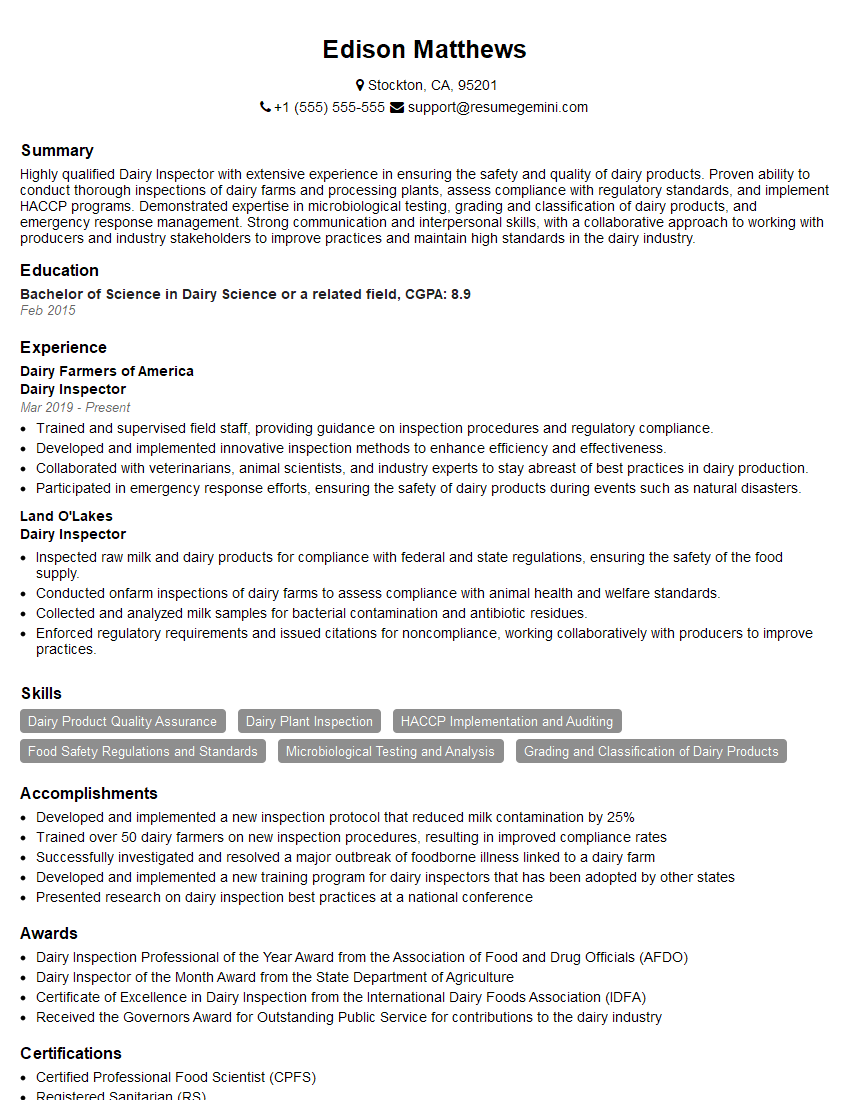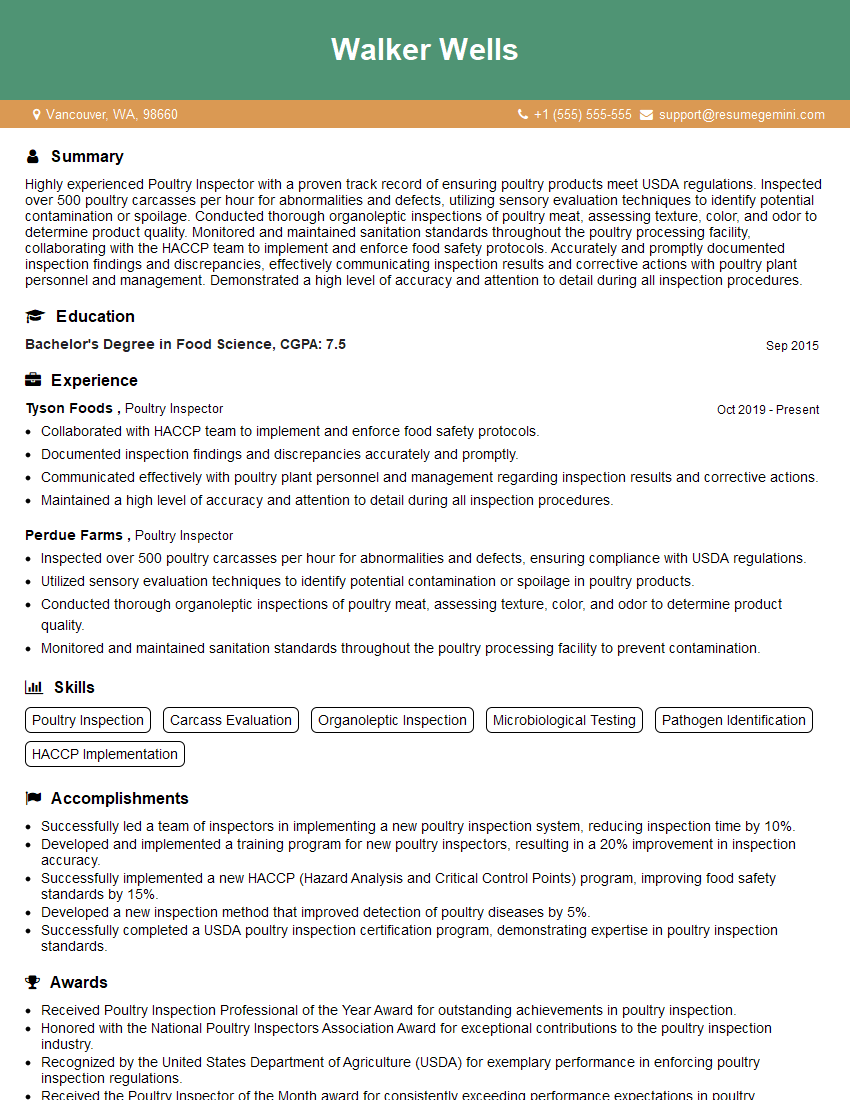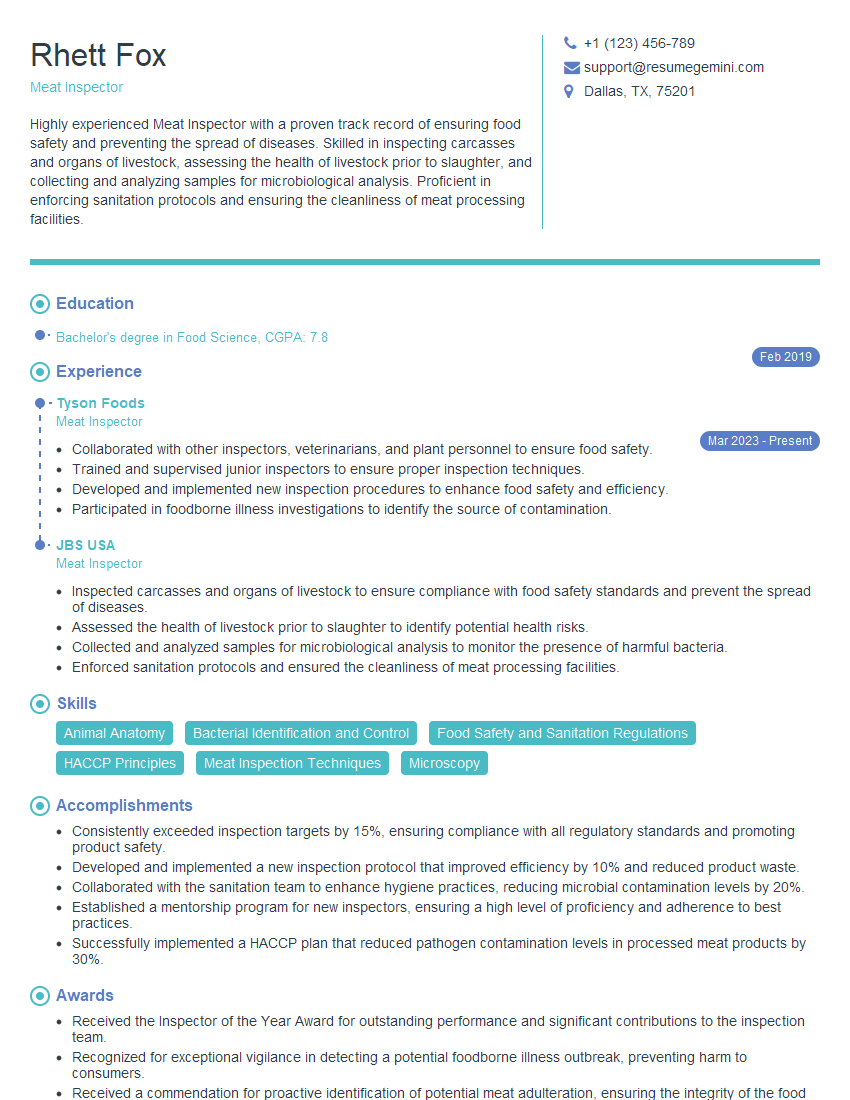The right preparation can turn an interview into an opportunity to showcase your expertise. This guide to USDA Grading Standards interview questions is your ultimate resource, providing key insights and tips to help you ace your responses and stand out as a top candidate.
Questions Asked in USDA Grading Standards Interview
Q 1. Explain the difference between USDA Prime, Choice, and Select grades for beef.
USDA Prime, Choice, and Select grades for beef represent different levels of quality, primarily based on marbling (intramuscular fat) and maturity. Think of it like this: marbling is the beautiful flecks of fat within the lean meat; more marbling generally means more flavor and tenderness.
- Prime: This is the highest grade, boasting abundant marbling, resulting in exceptional flavor and tenderness. It’s often found in high-end steakhouses.
- Choice: A very popular grade, Choice beef has moderate marbling, offering excellent flavor and tenderness. It’s a great balance of quality and price, making it a common choice for home cooks.
- Select: This grade has less marbling than Choice, resulting in leaner meat that is still tender but may lack the intense flavor of Prime or Choice. It’s often a more budget-friendly option.
The grading also considers factors like maturity (age of the animal) and firmness, but marbling is the key differentiator between these three grades. A steak graded Prime will generally be juicier and more flavorful than one graded Select.
Q 2. Describe the factors considered when grading poultry.
USDA poultry grading considers several factors to assess quality. It’s not just about size; it’s about the overall condition of the bird.
- Conformation: This refers to the shape and form of the bird. A well-conformed bird has a desirable plumpness and well-developed breast.
- Fleshing: This describes the amount of meat on the bird’s frame. A well-fleshed bird is meaty and desirable.
- Fat covering: The amount of fat covering the bird affects its appearance and juiciness. Too little or too much fat can lower the grade.
- Absence of defects: This includes things like bruises, discoloration, and missing parts. Any significant defect can lower the grade significantly.
Graders visually inspect the birds and use their hands to assess the meat’s firmness and feel. A Grade A bird will be well-conformed, well-fleshed, have a desirable fat covering, and be free from defects.
Q 3. What are the key characteristics of USDA Grade A eggs?
USDA Grade A eggs are considered the highest quality. The grading focuses on the interior and exterior quality of the egg.
- Shell quality: The shell should be clean, sound, and free from cracks or abnormal shapes. Think of it like a protective shield for the precious contents inside.
- Albumen (white) quality: The albumen should be thick and firm, indicating freshness and high quality. The thicker the white, the fresher the egg.
- Yolk quality: The yolk should be round, firm, and free from defects. A high-quality yolk will stand tall in the center of the white.
- Air cell size: A small air cell size indicates freshness. The air cell is the small pocket of air between the yolk and the shell at the large end of the egg.
Grade A eggs are ideal for frying, poaching, boiling – essentially any cooking method where egg quality is important. While Grade B eggs are still safe to eat, they may have a thinner white or flatter yolk and are often used for baking or other applications where appearance isn’t as critical.
Q 4. How does the USDA grade fruits and vegetables?
USDA grading for fruits and vegetables is based on factors that influence their appearance, size, and overall quality. It’s a complex system with variations depending on the specific produce.
- Size and shape: Uniformity is often a key factor, with premium grades featuring fruits and vegetables of similar size and shape.
- Color and appearance: The intensity and uniformity of color are considered; blemishes and imperfections can lower the grade.
- Maturity: The produce must be properly mature but not overripe.
- Freedom from defects: This includes bruises, decay, insect damage, and other defects.
Grading standards are often specific to each type of fruit or vegetable. For example, apples are graded based on color, size, and the absence of bruises, while tomatoes are graded based on shape, color, and firmness. Imagine buying a box of beautiful, uniformly red tomatoes; that’s likely a high-grade product.
Q 5. Explain the role of USDA grading in ensuring food safety.
While USDA grading doesn’t directly ensure food safety (that’s the role of the Food Safety and Inspection Service), it plays an indirect but crucial role. High grades indicate superior quality, which often correlates with better handling and storage practices.
For example, a high-grade beef carcass will likely have undergone proper chilling and handling, minimizing the risk of bacterial contamination. Similarly, a high grade for eggs implies proper handling and storage, reducing the chances of spoilage. So while it’s not a safety certification, higher grades often reflect processes that are more likely to prevent foodborne illnesses. It’s about quality leading to better handling practices, reducing the risk of problems down the line.
Q 6. What are the different classes of grain and how are they determined?
Grain is classified into different classes based on factors like quality, type, and intended use. The USDA uses a complex system. Here’s a simplified overview:
- Wheat: Classes include Hard Red Winter, Hard Red Spring, Soft Red Winter, White Wheat, and Durum. These are based on protein content, kernel hardness, and other characteristics that affect their baking properties. Hard wheat has more protein and is suitable for bread, while soft wheat is used for cakes and pastries.
- Corn: Classes include Yellow Dent, White Dent, and Flint. The classification is determined primarily by kernel type and color.
- Oats: Classes include Oats and White Oats; differentiation is based on hull type and color.
- Rice: Long-grain, medium-grain, and short-grain rice are distinguished based on kernel length and cooking characteristics.
The determination of grain class involves laboratory analyses and visual inspections. Factors such as protein content, moisture content, damaged kernels, foreign materials, and test weight are crucial in determining the final grade. Think of it as a detailed evaluation ensuring consistent quality for different food applications.
Q 7. Describe the visual and tactile assessments used in grading meat.
Visual and tactile assessments are critical in meat grading. It’s a combination of what a grader sees and feels that determines the final grade.
- Visual assessment: Graders carefully observe the color, texture, and fat distribution of the meat. For example, the color of beef should be bright red, and the fat should be a creamy white color. Excessive discoloration or dark areas can indicate problems.
- Tactile assessment: Graders use their hands to feel the firmness and texture of the meat. Firmness is a key factor in assessing meat quality. The feel of the meat can indicate how well it has been handled and stored.
Imagine a grader feeling a beef carcass – they’re assessing the firmness, texture, and yield. A firm texture indicates good quality and better marbling. This tactile assessment, along with the visual inspection, allows them to determine the appropriate grade, ensuring consumers receive consistent quality.
Q 8. What are the consequences of inaccurate USDA grading?
Inaccurate USDA grading can have serious consequences, impacting both producers and consumers. For producers, inaccurate grading can lead to significant financial losses if their products are graded lower than they deserve, resulting in reduced market value and potential for legal disputes. Conversely, an overly generous grade could unfairly disadvantage producers with genuinely higher-quality products. For consumers, inaccurate grading undermines trust in the system. It can lead to purchasing products that don’t meet expected quality standards, resulting in dissatisfaction and potential health risks if, for example, meat is improperly graded and contains unsafe levels of contaminants. The reputation of the entire industry can also suffer from widespread inaccuracies, damaging consumer confidence and impacting market stability.
Imagine a farmer who meticulously raises cattle, adhering to high standards of animal welfare and feed. If their beef is inaccurately graded lower than its quality warrants, they lose potential profits and face unfair competition. Similarly, a consumer purchasing ‘Prime’ grade beef expecting exceptional tenderness and marbling might be disappointed with an inferior product if the grading was flawed, leading to distrust and dissatisfaction.
Q 9. How are USDA grading standards enforced?
USDA grading standards are enforced through a combination of rigorous training, certification programs, and on-site inspections. Graders undergo extensive training to master the complex grading criteria for various products, such as meat, poultry, and dairy. They are certified and regularly monitored to maintain consistent and accurate grading. USDA inspectors conduct random audits of processing plants and facilities to ensure compliance with the standards. These audits verify the accuracy of grading practices and identify any potential deviations. Furthermore, the USDA employs a system of appeals and dispute resolution to address grading discrepancies that may arise. Producers or other stakeholders can challenge a grade, initiating a review process to ensure fairness and accuracy.
Think of it like a quality control system, but on a massive scale. Regular audits are the equivalent of spot checks at a factory, and the appeals process is like an internal review board to handle any complaints.
Q 10. What are the common defects found in meat and poultry?
Common defects found in meat and poultry vary depending on the type of product, but some frequently encountered issues include bruises, discoloration, excessive fat trimming, freezer burn (in frozen products), and the presence of foreign materials. In poultry, bone breakage and skin tears are also common. These defects can affect the final grade assigned to the product, lowering its market value. The severity and extent of the defect are important factors considered during grading. For example, a small bruise might result in a minor grade reduction, while widespread bruising or severe discoloration could significantly impact the grade.
- Bruises: Caused by physical trauma during handling.
- Discoloration: Can result from improper storage or processing.
- Excessive Fat Trimming: Reduces yield and may affect quality.
- Freezer Burn: Damage caused by improper freezing and storage.
- Foreign Materials: Contamination from processing or handling.
Q 11. How does temperature affect the grading of perishable goods?
Temperature plays a critical role in the grading of perishable goods like meat and poultry. Maintaining the correct temperature throughout the cold chain (from processing to retail) is crucial for preserving quality and preventing spoilage. Improper temperature control can lead to significant quality degradation, affecting factors considered during grading, such as color, texture, and odor. For instance, meat exposed to fluctuating temperatures or allowed to reach unsafe temperatures might exhibit undesirable discoloration, changes in texture and tenderness, and off-odors, negatively impacting its grade. USDA guidelines strictly regulate temperature control during storage and transport to maintain the quality of graded products. Products that fail to meet these temperature requirements may receive a lower grade or be rejected entirely.
Think of it like baking a cake: if you leave it in the oven too long, or at the wrong temperature, it will not turn out as expected. Similarly, improper temperatures will affect the quality and final grade of perishable goods.
Q 12. Explain the process of grading dairy products.
The grading of dairy products, such as milk and cheese, involves evaluating several key factors related to composition, quality, and safety. Milk grading focuses on aspects like bacterial count, fat content, and the absence of undesirable substances. Cheese grading considers factors like texture, flavor, aroma, and appearance. The process often begins with a preliminary assessment, followed by laboratory analysis to determine precise compositional attributes. Sensory evaluation by trained graders plays a significant role, ensuring the overall quality of the dairy product meets the established standards. Different grades are assigned depending on the results of these analyses and sensory evaluations, with higher grades indicating superior quality.
A cheese grader, for example, will assess the texture, appearance, and aroma of the cheese, assigning points based on these features. Then, laboratory testing will confirm fat content and other relevant aspects.
Q 13. What are the requirements for USDA organic certification?
The USDA organic certification process is rigorous and designed to verify that agricultural products meet strict criteria throughout the entire production process. To obtain certification, producers must demonstrate adherence to specific guidelines related to soil management, pest control, livestock handling, and the prohibited use of synthetic fertilizers, pesticides, GMOs, and antibiotics. They must maintain detailed records of their farming practices, and their operations undergo regular inspections by USDA-accredited certifying agents. Certification is not granted automatically; it requires thorough documentation and successful completion of rigorous audits. The certification process helps ensure that consumers can reliably purchase products meeting the USDA’s definition of organic farming.
This is similar to receiving a quality seal for a product – it ensures the product meets specific standards and the consumer has a guaranteed experience.
Q 14. How do you handle a grading discrepancy?
Handling a grading discrepancy requires a systematic approach to ensure fairness and accuracy. First, a thorough review of the grading process is conducted to identify any potential errors or inconsistencies. This might involve re-examining the product itself, verifying the grading procedures followed, and reviewing the grader’s qualifications and training. If the discrepancy persists, an appeal process is initiated, involving a higher-level review and potentially a second grading by an experienced grader. Documentation is crucial throughout the process, meticulously recording all steps taken and the evidence supporting the claims of the involved parties. Transparency and fairness are paramount in resolving grading disputes, maintaining the integrity of the USDA grading system.
Think of it as an investigation. All evidence needs to be considered before a final decision is reached.
Q 15. Describe your experience with USDA grading guidelines.
My experience with USDA grading guidelines spans over 15 years, encompassing various agricultural products, primarily focusing on meat and poultry. I’ve worked directly with producers, processors, and retailers, providing grading services and training on the standards. My expertise includes not only the application of the grading standards but also a deep understanding of the underlying science and principles. This allows me to effectively communicate grading results and justifications to diverse stakeholders. I’ve also been involved in several internal audits to ensure compliance and identify areas for improvement in our grading processes.
For instance, I’ve helped numerous producers refine their practices to achieve higher grades for their products, leading to improved market value and profitability. I’ve also worked on resolving grading disputes through clear explanations and objective evaluations, demonstrating the fairness and transparency of the USDA grading system.
Career Expert Tips:
- Ace those interviews! Prepare effectively by reviewing the Top 50 Most Common Interview Questions on ResumeGemini.
- Navigate your job search with confidence! Explore a wide range of Career Tips on ResumeGemini. Learn about common challenges and recommendations to overcome them.
- Craft the perfect resume! Master the Art of Resume Writing with ResumeGemini’s guide. Showcase your unique qualifications and achievements effectively.
- Don’t miss out on holiday savings! Build your dream resume with ResumeGemini’s ATS optimized templates.
Q 16. What are the latest updates to USDA grading standards?
The USDA regularly updates its grading standards to reflect changes in production practices, consumer preferences, and technological advancements. Recent updates have focused on improving efficiency, clarity, and accuracy. For example, there have been refinements in the descriptions for certain quality attributes (like marbling in beef or color in poultry) to reduce ambiguity and improve consistency across grading personnel. There’s also been an increased emphasis on incorporating technology for objective measurement and data analysis, leading to more precise grading and reduced reliance on subjective assessments.
Specific updates often target individual commodities. For instance, recent changes in poultry grading might focus on improved methods for assessing breast meat yield, while changes in beef grading could refine the assessment of tenderness based on new scientific research. Staying abreast of these modifications is crucial for maintaining accuracy and compliance.
Q 17. How do you maintain accuracy and consistency in your grading?
Maintaining accuracy and consistency in USDA grading requires a multi-faceted approach. First, rigorous training is essential. All graders undergo extensive training on the specific grading standards for each commodity, including practical experience with various products. This training ensures everyone understands the standards and grading procedures accurately. Regular calibration and proficiency tests are used to monitor each grader’s performance and ensure consistency with established benchmarks. We also employ standardized grading procedures and tools to minimize variability. These procedures help to ensure that everyone is assessing products using the same methods and criteria, reducing subjective biases.
Furthermore, internal quality control measures such as blind audits and cross-checking of grading results help identify any inconsistencies and ensure continuous improvement. Finally, regular communication and collaboration among graders are crucial. This fosters a culture of continuous learning and refinement, ensuring everyone is on the same page regarding the standards and interpretation of grades.
Q 18. What are the ethical considerations in USDA grading?
Ethical considerations in USDA grading are paramount. Impartiality and objectivity are non-negotiable. Graders must remain unbiased in their assessments, ensuring the grading process is fair and equitable for all producers. Conflicts of interest, such as personal relationships with producers or financial incentives for awarding specific grades, must be avoided at all costs. Maintaining confidentiality of grading information is also crucial, protecting the sensitive business information of producers. Transparency and accountability are vital – producers should have a clear understanding of the grading process and the rationale behind the assigned grade, with mechanisms in place to address concerns or disputes.
Any deviation from these ethical principles can severely undermine the credibility and integrity of the USDA grading system, which is why strict codes of conduct and oversight mechanisms are in place.
Q 19. Explain your understanding of the USDA’s role in food inspection.
The USDA plays a crucial role in food inspection and grading, ensuring the safety and quality of the nation’s food supply. Their role goes beyond grading; it encompasses inspecting facilities, processes, and the products themselves to ensure compliance with safety regulations and quality standards. The USDA ensures that food is safe for consumption, accurately labeled, and meets the quality expectations consumers rightfully expect. This encompasses a wide range of agricultural products, from meat and poultry to fruits and vegetables, and even processed foods.
The USDA works through several agencies, with the Food Safety and Inspection Service (FSIS) being a key player in meat and poultry inspection, while other agencies handle the inspection and grading of other products. The overall goal is to protect public health and ensure fair practices within the food industry.
Q 20. How would you address a situation with a producer who disagrees with a grading decision?
Addressing a situation with a producer who disagrees with a grading decision requires a calm, professional, and transparent approach. The first step is to carefully review the grading process and documentation to ensure accuracy and identify any possible errors or misunderstandings. I would patiently explain the grading criteria and the rationale behind the assigned grade, using clear and simple language that the producer can easily understand. I would also welcome their concerns and give them the opportunity to express their perspective.
If the disagreement persists, I would offer a re-inspection by a senior grader or a team of graders to provide a second opinion. If the initial grade is upheld, I would explain this decision clearly and fairly, emphasizing the objectivity and consistency of the USDA grading standards. If possible, I would offer guidance to help the producer improve their production practices to achieve higher grades in the future. Documenting the entire process is crucial to maintain transparency and accountability.
Q 21. What are the different types of grading equipment used?
The types of grading equipment used vary depending on the commodity. For meat grading, tools include probes for measuring fat thickness, scales for determining weight, and specialized instruments for assessing marbling, color, and texture. These can range from simple rulers and gauges to sophisticated optical devices and imaging systems. Poultry grading involves equipment to assess weight, breast meat yield, and visual quality attributes such as skin condition and color.
For fruits and vegetables, instruments may include calipers to measure size and shape, colorimeters to measure color intensity, and devices to assess firmness and maturity. Technology is continuously being integrated; for instance, advanced imaging systems are increasingly utilized for objective and efficient assessment of various quality attributes, reducing reliance on purely visual grading.
Q 22. What are your strengths and weaknesses in performing grading tasks?
My greatest strength in USDA grading is my meticulous attention to detail. I understand that even minor inconsistencies can significantly impact the final grade, affecting both the producer and the consumer. I’m methodical in my approach, ensuring each step of the grading process is followed precisely. For example, when grading beef, I meticulously examine marbling, color, and texture, referencing the official USDA standards at every point. My weakness, however, lies in my sometimes perfectionistic nature. I can spend more time on a single grading task than is strictly necessary. I’m actively working to improve my time management skills in a high-volume setting without compromising accuracy. I find that checklists and timed practice runs help significantly.
Q 23. Describe your experience working in a fast-paced environment related to food inspection.
In my previous role at a large meat processing facility, I regularly handled high volumes of product under strict time constraints. During peak seasons, we would process hundreds of carcasses daily, demanding swift and accurate grading. This environment honed my ability to prioritize tasks efficiently and maintain accuracy under pressure. For example, we often faced unexpected equipment malfunctions or supply chain disruptions, forcing us to adapt and re-prioritize on the fly. The experience taught me to anticipate potential problems and establish contingency plans, maintaining consistent output despite challenges.
Q 24. How familiar are you with the USDA’s Food Safety and Inspection Service (FSIS)?
I’m extremely familiar with the FSIS. My understanding extends beyond simply knowing their existence; I’m deeply knowledgeable about their role in ensuring the safety and wholesomeness of our nation’s meat and poultry supply. I understand the regulations they enforce, the inspection procedures they mandate, and the consequences of non-compliance. I’m aware of the various directives and guidelines, including the Hazard Analysis and Critical Control Points (HACCP) system and the Sanitary Standard Operating Procedures (SSOPs). Understanding the FSIS’s role is crucial for effective and compliant grading, as the grading process is intrinsically linked to food safety protocols.
Q 25. Explain your experience using USDA grading documentation and forms.
I have extensive experience using USDA grading documentation and forms. I’m proficient in accurately recording observations, grades, and any other relevant information according to the prescribed format. I’m familiar with both electronic and paper-based systems, and I understand the importance of maintaining detailed and accurate records for traceability and audit purposes. For example, I’ve worked with the specific forms used for grading beef, poultry, and pork, each with its unique requirements and data fields. My experience ensures complete, accurate, and compliant documentation throughout the grading process.
Q 26. How do you stay updated on changes in USDA grading regulations?
Staying updated on changes to USDA grading regulations is paramount. I utilize several methods: I subscribe to the USDA’s official publications and email newsletters, I regularly attend industry conferences and workshops, and I actively participate in professional organizations related to meat grading. Additionally, I maintain a network of colleagues in the field, exchanging information and best practices. This multi-faceted approach guarantees I’m consistently informed of any regulatory changes, ensuring my grading practices remain current and compliant.
Q 27. What is your approach to ensuring fair and unbiased grading practices?
Fair and unbiased grading is the cornerstone of my work. I adhere strictly to the official USDA standards and guidelines, consistently applying the same criteria to all products. I avoid any personal biases or external influences that could compromise objectivity. For example, I maintain a blind grading system whenever possible, meaning I’m unaware of the producer or the origin of the product before beginning the assessment. Regular calibration checks and internal audits further enhance the fairness and accuracy of my grading. My commitment is to consistently deliver impartial and accurate assessments, maintaining the integrity of the USDA grading system.
Q 28. Describe a time you had to troubleshoot a problem related to grading accuracy.
During a particularly busy grading shift, we encountered a discrepancy in the fat content readings for a batch of pork. The initial measurements consistently exceeded the acceptable range for the intended grade. Instead of simply downgrading the entire batch, I systematically investigated the potential causes. I reviewed the calibration of the equipment, checked the sampling techniques employed, and even reviewed the chain of custody for the pork to rule out any labeling errors. Ultimately, we discovered a minor malfunction in the measuring equipment, leading to inaccurate readings. Once corrected, the readings aligned with the expected fat content, and the correct grade could be assigned. This experience highlighted the importance of methodical troubleshooting and the necessity to verify measurements before making critical decisions that impact product classification and value.
Key Topics to Learn for USDA Grading Standards Interview
- Meat Grading: Understand the various grades (e.g., Prime, Choice, Select) and the factors influencing them (e.g., marbling, maturity, firmness).
- Poultry Grading: Learn the grading criteria for poultry, including factors like conformation, fleshing, and fat covering. Practice applying these standards to different poultry types.
- Fruit and Vegetable Grading: Familiarize yourself with the grading standards for various fruits and vegetables, considering factors like size, shape, color, and defects.
- Grading Procedures and Documentation: Understand the proper procedures for conducting grading, including sample selection, evaluation techniques, and accurate record-keeping. Practice documenting your findings clearly and concisely.
- Quality Control and Assurance: Learn about the role of USDA grading in maintaining quality and ensuring consumer safety. Be prepared to discuss quality control measures and their application.
- Regulations and Compliance: Become familiar with relevant USDA regulations and guidelines related to grading. Understand the importance of compliance and potential consequences of non-compliance.
- Technological Advancements: Explore how technology (e.g., imaging systems) is being used to improve grading efficiency and accuracy. Be prepared to discuss the advantages and challenges of these technologies.
- Problem-Solving in Grading: Practice identifying and resolving common issues encountered during the grading process. This includes dealing with ambiguous cases and applying sound judgment.
Next Steps
Mastering USDA Grading Standards is crucial for career advancement in the agricultural and food industries, opening doors to specialized roles and increased earning potential. A strong resume is essential to showcasing your skills and experience to potential employers. Building an ATS-friendly resume significantly increases your chances of getting noticed by recruiters. ResumeGemini is a trusted resource to help you create a professional and impactful resume, tailored to highlight your expertise in USDA Grading Standards. Examples of resumes tailored to USDA Grading Standards are available to help guide your process.
Explore more articles
Users Rating of Our Blogs
Share Your Experience
We value your feedback! Please rate our content and share your thoughts (optional).
What Readers Say About Our Blog
good





